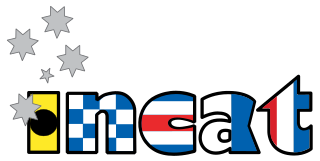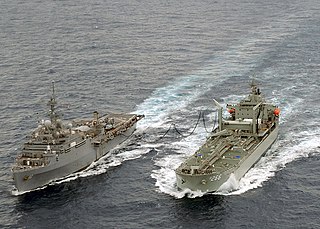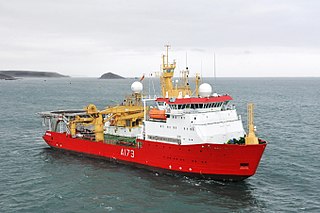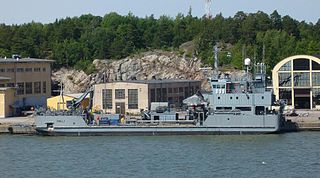
A passenger ship is a merchant ship whose primary function is to carry passengers on the sea. The category does not include cargo vessels which have accommodations for limited numbers of passengers, such as the ubiquitous twelve-passenger freighters once common on the seas in which the transport of passengers is secondary to the carriage of freight. The type does however include many classes of ships designed to transport substantial numbers of passengers as well as freight. Indeed, until recently virtually all ocean liners were able to transport mail, package freight and express, and other cargo in addition to passenger luggage, and were equipped with cargo holds and derricks, kingposts, or other cargo-handling gear for that purpose. Only in more recent ocean liners and in virtually all cruise ships has this cargo capacity been eliminated.

The Albion-class landing platform dock is a class of amphibious assault ship in service with the Royal Navy. The class consists of two vessels, HMS Albion and HMS Bulwark, ordered in 1996 to replace the ageing Fearless class. Both ships were built by BAE Systems Marine at the former Vickers Shipbuilding and Engineering yard in Barrow-in-Furness. Albion was commissioned in 2003 and Bulwark in 2004. Each of the ships has a crew of 325 and can accommodate up to 405 troops. Thirty-one large trucks and thirty-six smaller vehicles and main battle tanks can be carried inside the vehicle deck. To disembark troops and vehicles, the vessels are equipped with eight landing craft.

A cargo ship or freighter ship is a merchant ship that carries cargo, goods, and materials from one port to another. Thousands of cargo carriers ply the world's seas and oceans each year, handling the bulk of international trade. Cargo ships are usually specially designed for the task, often being equipped with cranes and other mechanisms to load and unload, and come in all sizes. Today, they are almost always built by welded steel, and with some exceptions generally have a life expectancy of 25 to 30 years before being scrapped.

A merchant ship, merchant vessel, trading vessel, or merchantman is a watercraft that transports cargo or carries passengers for hire. This is in contrast to pleasure craft, which are used for personal recreation, and naval ships, which are used for military purposes.

Incat Tasmania is a manufacturer of high-speed craft (HSC) catamaran ferries. Its greatest success has been with large, sea going passenger and vehicle ferries, but it has also built military transports and since 2015 it has built smaller river and bay ferries. Based in Derwent Park, a suburb of Hobart, Tasmania, Australia, it was founded by Bob Clifford.

MT Mastera is a Finnish Aframax crude oil tanker operated by Neste Shipping. She and her sister ship, Tempera, are the first ships to utilize the double acting tanker (DAT) concept, developed by Aker Arctic, in which the vessel is designed to travel ahead in open water and astern in severe ice conditions. The two icebreaking tankers are used to transport crude oil year round from the Russian oil terminal in Primorsk to Neste Oil refineries in Porvoo and Naantali.

La Noumbi is a floating production storage and offloading (FPSO) unit operated by Perenco. The vessel, converted from the former Finnish Aframax crude oil tanker Tempera by Keppel Corporation, will replace an older FPSO unit in the Yombo field off the Republic of Congo in 2018.

A replenishment oiler or replenishment tanker is a naval auxiliary ship with fuel tanks and dry cargo holds which can supply both fuel and dry stores during underway replenishment (UNREP) at sea. Many countries have used replenishment oilers.

A crane vessel, crane ship or floating crane is a ship with a crane specialized in lifting heavy loads. The largest crane vessels are used for offshore construction. Conventional monohulls are used, but the largest crane vessels are often catamaran or semi-submersible types as they have increased stability. On a sheerleg crane, the crane is fixed and cannot rotate, and the vessel therefore is manoeuvered to place loads.

USNS Apache (T-ATF-172), fifth United States Navy ship of the name, is the last of the Powhatan class of fleet ocean tugs. Apache was delivered to the U.S. Navy in 1981. She is operated by Military Sealift Command and crewed by 18 civil service mariners (CIVMARS). She is designed to provide the Navy with towing service, and when augmented by Navy divers, assist in the recovery of downed aircraft and ships. There are quarters on board for up to 22 additional personnel.

A heavy-lift ship is a vessel designed to move very large loads that cannot be handled by normal ships. They are of two types:

An oil tanker, also known as a petroleum tanker, is a ship designed for the bulk transport of oil or its products. There are two basic types of oil tankers: crude tankers and product tankers. Crude tankers move large quantities of unrefined crude oil from its point of extraction to refineries. For example, moving crude oil from oil wells in Nigeria to the refineries on the coast of the United States. Product tankers, generally much smaller, are designed to move refined products from refineries to points near consuming markets. For example, moving gasoline from refineries in Europe to consumer markets in Nigeria and other West African nations.

HSwMS Belos (A214) is a submarine rescue ship in the Swedish Navy's 1st Submarine flotilla. She carries the Submarine Rescue Vehicle URF. She is also capable of carrying the NATO rescue system NSRS. HSwMS Belos is currently [2017] the largest ship in the Swedish Navy. HMS Belos is traditionally the name of the Swedish navy's submarine rescue vessel and she is the third ship with that name.

Azov Shipyard is the largest ship repair enterprise in the Sea of Azov (Ukraine) specializing in ship repair, shipbuilding, mechanical engineering and cargo transshipment. Azov Shipyard is being managed by Management Company Mariupol Investment Group . Dmitriy Lyashov is the General Director of Azov Shipyard. The shipyard was formerly known as Zhdanov Shipyard. The shipyard has since privatized and is known as Azov ship-repair factory enterprise and is subordinate to System Capital Management.

CCGS George R. Pearkes is a Martha L. Black-class light icebreaker and buoy support vessel in the Canadian Coast Guard. Named for Victoria Cross-winner George Pearkes, the ship entered service in 1986. Initially assigned to Pacific region, the vessel transferred to the Quebec region. George R. Pearkes was assigned to her current deployment, the Newfoundland and Labrador region in 2004.

HMS Protector is a Royal Navy ice patrol ship built in Norway in 2001. As MV Polarbjørn she operated under charter as a polar research icebreaker and a subsea support vessel. In 2011, she was chartered as a temporary replacement for the ice patrol ship HMS Endurance and was purchased outright by the British Ministry of Defence in September 2013.

Louhi is a Finnish multipurpose oil and chemical spill response vessel owned by the Finnish Environment Institute (SYKE), but manned and operated by the Finnish Navy. The ship, ordered in 2007, was built by Uki Workboat in Uusikaupunki, Finland, and entered service in May 2011.

Patiño is a replenishment oiler of the Spanish Navy. It was named after the Spanish navy minister José Patiño Rosales, who reorganized the fleet on the orders of Philip V of Spain. The vessel was ordered in 1991 from Navantia and built at their yard in Ferrol, Galicia. The ship entered service with the Spanish Navy in June 1995 and is homeported at Ferrol. Patiño has been deployed with NATO forces around the world, participating in missions in the Kosovo War, the War in Afghanistan along with the European Union's anti-piracy mission to Somalia.

Halli (899) is a modified, enlarged Hylje-design, and acts as a combined pollution cleanup and vehicle transport ship. She is also operated by a civilian crew from the Ministry of Environment but is under navy control. The vessel can act as a landing ship and logistic support vessel. The 11-metre (36 ft) bow ramp can be used to load or unload vehicles up to 48 tons. As a cleanup vessel, she can sweep a 30-metre (98 ft) path at 1.5 knots with her MacGregor-Navire MacLORI pollution collection system. The vessel is equipped with a 360-cubic-metre (13,000 cu ft) waste-collection tank. The ship was built in 1986 and refitted in 2010.

The Samudra-class Pollution Control Vessel is a class of three vessels being built by the ABG Shipyard in Gujarat for Indian Coast Guard.





















